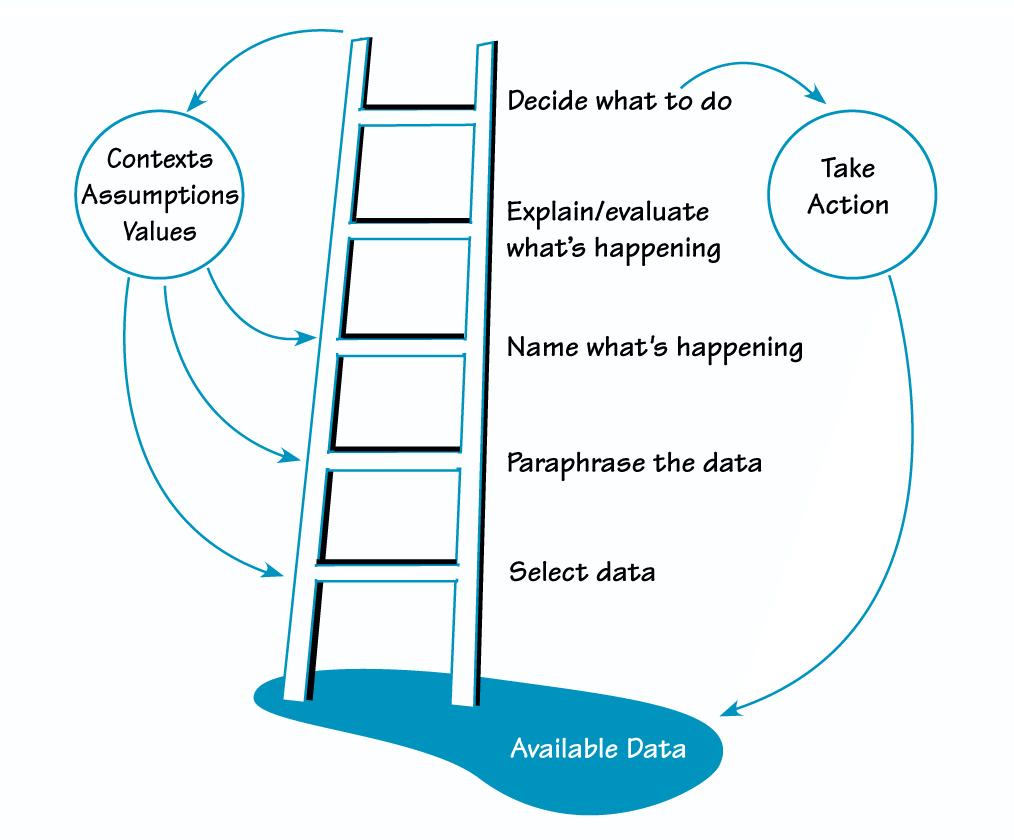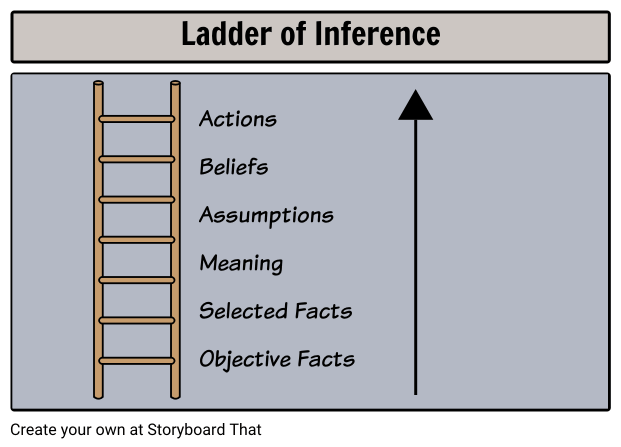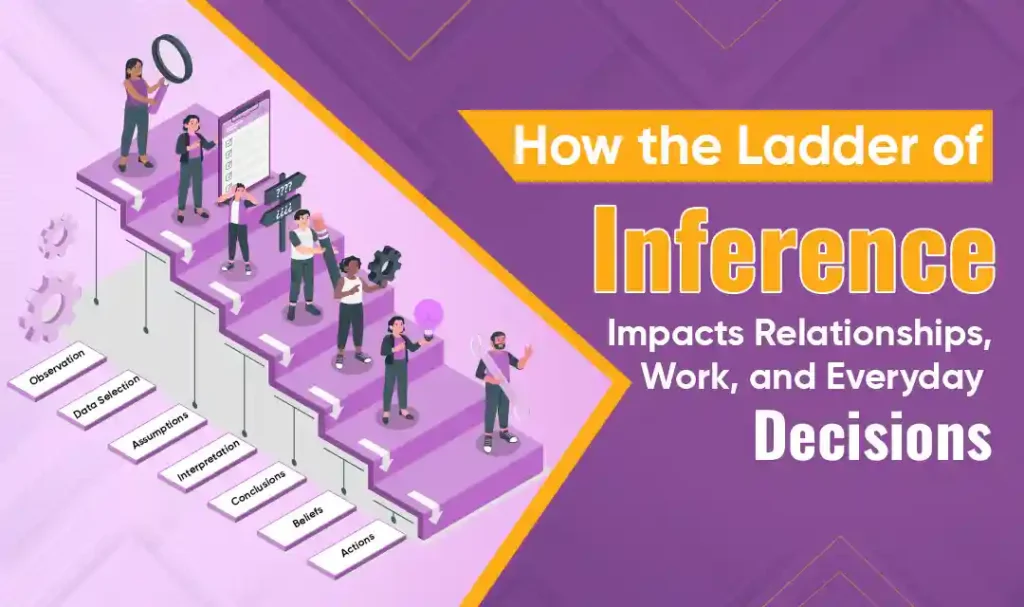The concept of Ladder of Inference was introduced by Chris Argyris who was a organisational psychologist, in the 1970s. When we move from observing reality to taking action, and the entire process often happens in mere seconds this ladder explains the entire process. While this process is natural, it can lead to faulty conclusions and strained interactions if you leave it unchecked.
On this ladder, each step is shown by a rung present on the ladder. It means that you will have to look at the bottom and then climb upwards before you make a decision and take the required action. Furthermore, you can greatly benefit from this ladder if you want to show the impact of your thought process on your work, everyday decisions and relationships.
In this article, we are going to explore how the Ladder of Inference shapes our relationships, professional environments, and daily decision-making. It is important to understand this cognitive process as you can use it to empower yourself to respond with clarity and intention rather than reacting from assumption and bias.
Let’s dive deeper into the details.
What Is The Ladder of Inference?
According to The Systems Thinker, the Ladder of Inference is known as a fair model which is used by people to figure out different situations so that they can act properly. It improves their thinking and coordinates their thought processes with others. Usually, this ladder is known for taking into account everything that surrounds us in daily life.
Mostly, in the psychology departments, students are trained to identify the patterns related to the ladder of inference in depth. Depending on the kinds of situations they observe and their interpretations, they are encouraged to use the information for different purposes.

Image Credit: The Systems Thinker
10 Ways Ladder of Inference Impacts Relationships, Work, And Everyday Decisions
As we have discussed earlier, the Ladder of Inference is commonly used to illustrate how people move from observable data to actions based on beliefs, assumptions, and conclusions in an often unconscious manner. So when we are taking this mental shortcut, it can easily distort perception, escalate conflict, and sabotage outcomes if not checked.
Students in psychology are advised to understand this concept thoroughly so that they can describe its impact on work, relationships, and everyday decisions in assignments. In case they find it challenging, they can easily consult London-based assignment writing services to assist them in writing their papers with precision and clarity.
Let’s now see how this ladder can leave an impact on everyday decisions, work and relationships of people.
1. Misinterpretation in Relationships
People often filter what others say or do through personal experiences or insecurities. A partner arriving home late can be viewed as someone who is as disinterested or dishonest, even the case may be that if they were stuck in traffic.
The Ladder of Inference will then trigger the assumptions based on selective data (“they didn’t call”), leading to a story (“they’re avoiding me”) and reaction (“I’ll ignore them back”). These unchecked mental jumps are the main ingredients behind the misunderstanding and emotional distance, which is quite common in many communities across the world.
2. Workplace Conflict and Miscommunication
It is almost needless to say that in professional settings, the Ladder of Inference often causes various communication breakdowns. A manager will look at a team member on their phone during a meeting and assume that they are disengaged. Without clarifying, they will be labelling the employee as lazy, which shall further lead to affecting trust and collaboration. Such leaps up the ladder, observing, interpreting, concluding, and then acting can also undermine workplace harmony and reduce team performance.
3. Biased Hiring Decisions
We also see that hiring managers sometimes make decisions based on “gut feeling,” which can be heavily influenced by unconscious bias. They may be unconsciously selecting the data that aligns with personal preferences (e.g., similar background or communication style), and then climb the ladder.
Lastly, they shall make the mistake of choosing a candidate prematurely. This leads to unwanted results and also restricts diversity and overlooks qualified applicants. Being aware of this tendency can encourage more structured, fair evaluations in the hiring processes in different companies around the world.
4. Escalating Arguments from Assumptions
Arguments are often escalated because both parties are operating on inferred beliefs rather than facts. For instance, a friend not replying to a message might be immediately assumed to be angry or ignoring you. After that, responding with passive-aggression or confrontation without checking the facts worsens the situation. However, if one prefers to step back to question assumptions, it will prevent unnecessary conflict.
If you start to pay attention to the core reason of all argumentation, you will find out that the main cause of conflict is your assumptions. Psychology students are often trained to detect patterns of this kind when have to write their assignments.
5. Leadership Blind Spots
Generally, the leaders may form opinions based on limited data and reinforce them over time. For example, a leader might assume an employee is resistant to change after they give a hesitant response in a meeting. Without questioning this belief, the leader may side-line the employee, which further leads to disengagement. The Ladder of Inference narrows a leader’s vision which results in the hampering of broad vision and inclusive decision-making. A fair assessment also becomes impossible.
Since, psychology students are not expected to work in the capacity of leadership roles, they might not be able to fully understand how to tackle the leadership blind spots. Such students buy assignments online to get model papers written by expert writers, tailored to their needs.
6. Consumer Decision-Making
When making purchases, especially online, people are prone to often jump to conclusions based on limited reviews, influencer posts, or branding. One negative review might be interpreted as a deal-breaker, even if it’s an outlier. Hence, they climb the ladder quickly and it leads to emotional or biased buying decisions rather than logical evaluation. However, if they are aware of this mental process, it usually leads to more balanced choices.
7. Cultural and Social Bias
We tend to make quick assumptions about people based on cultural cues, accents, or clothing. These snap judgments which are often drawn from societal conditioning easily lead us up the Ladder of Inference to form stereotypes. As a result, such bias influences behaviour, from avoiding someone to treating them unfairly. It is important to recognise this process if you want to foster empathy and equity in the people around you.
8. Self-Doubt and Internal Dialogue
We don’t just use the Ladder on others but we also turn it on ourselves. A single piece of feedback is more than enough to make us think that we are incompetent and not good enough for a role. “I missed one deadline” becomes “I’m unreliable” which then impacts confidence and performance. You might also start to notice how we climb the ladder and how internally helps maintain healthier self-perception and resilience.
An example of this can be seen best in different sorts of rhetoric analysis essays where you are studying the internal dialogue of characters in the form of a ladder of inference. These kinds of documents also sharpen the critical skills of students in their everyday lives.
9. Poor Team Decisions
Groupthink often stems from unexamined assumptions. In team meetings, a dominant voice can easily be interpreted as a market trend in a certain way, and others, without checking data or perspectives seem to agree. The team collectively climbs the ladder, leading to flawed strategies. That is why, it is important to encourage open dialogue, fact-checking, and diverse viewpoints if you want to interrupt this cycle.
10. Missed Opportunities in Everyday Life
From declining invitations based on assumed awkwardness to avoiding conversations due to imagined outcomes, the Ladder of Inference is used to limit the possibilities. People often act on imagined consequences rather than realities and all of this leads to avoidance, regret, or stagnation. Being mindful of how quickly we jump to conclusions opens us to richer experiences and wiser choices and we do not miss as many opportunities as we do if we are not mindful of our actions.
The Ladder of Inference is always at work as it shapes how we see the world, others, and ourselves. So, when you become aware of this mental model, it will become easy for you to interrupt the climb and stay grounded in facts. This simple yet powerful awareness can transform how we relate, lead, decide, and grow in relationships, in the workplace, and in everyday life.
What Are The 7 Steps Of The Ladder Of Inference?
As per Asana, there are 7 steps to the Ladder related to the Inference which represent the cognitive processes that are involved from the point of making observations to taking actions. The idea of this ladder has been practiced for a century and it explains in detail how people make and keep their assumptions about the world using this ladder.
No matter what the situation is, the 7 key elements of the ladder of inference scenarios always remain the same everywhere. For your increased practice, you can imagine several everyday life scenarios and try finding the basic steps of this ladder in those situations.
The key steps are discussed here in detail:
1. The Observation of Reality
In the very start, you will observe the existing states of the given scenario. You will not have made any interpretation yet – rather, you will just take in the reality of the circumstances that are in front of you. For instance, you can imagine that you are estimating the deadline for something that you need to do. When you work on a trend where you have to write 20 articles and each article is 2,000 words long, your key stakeholders are going to be the design team and the writing department.
2. The Selection of Data
Next up, you will be paying attention to the specific factors that are linked to your prior experiences and personal beliefs. This usually means that you are not going to consider all available data when you make a decision.
Instead, you use certain details based on your agenda or preferences. For instance, you may work on papers that are 2000 words long in length. In this example, you might be vigilant to know about what your writing team can craft before the deadline runs out. Within that time, you might ignore the fact that you have to work with the design team.
3. Adding Context to Data
In this step, the data has been selected already and in the context of your past beliefs and experiences, you shall analyse the data objectively. Sometimes, you may look at it through the lens of your personal observations and experiences.
For example, you put your efforts to work on a relevant project in the previous year but instead of working on ten articles of 1,000 words each, you have written 5 this time. It took you more than a week to craft and publish each of them, and it made 5 weeks overall.
However, in reality, you worked with the same design department in the previous year and they were able to upload the blog posts quickly within 2 days maximum. However, you are not aware if they will have the same bandwidth even this year or not.
4. Making Assumptions
Here, you shall make all the assumptions where you do not see if they are valid or not. You will apply it to the context of the situation that you are in. During this, we often ignore everything else and only focus on the assumptions that we have made.
For instance, you may think that a given project is similar to the one you did last year but that shall not be the case this year. During this, they may disregard any alternative viewpoints or explanations for your situation.
However, in reality, the design team may be busy accommodating the provision of their services to other departments, and they might not be able to prioritise the publishing of your blog articles like they did in the year that has passed.
5. Drawing Conclusions
Then, you will draw your conclusions by taking into account further assumptions about what a certain situation means and how we should act. For example, you may think that it will take you ten weeks for the purpose of writing and publishing an article which is 2000 words long.
However, in reality, the other team team shall have a low capacity as comapred to the last time and they may need a full week the publish each article. This means that for each article, it is going to be three weeks minimum and it shall put you at 20 weeks when the full campaign gets completed.
6. Adoption of Beliefs Based on Conclusions
Next up, you are going to transform into some sort of results that you shall carry till the very end with you in all future situations. This means that we have to continuously solidify our beliefs every time that we draw conclusions irrespective of the fact if these conclusions are considered right or not.
Usually, this process is also called a ‘reflexive loop’ which is a type of cycle. Due to this loop, our beliefs impact the ways we make our decisions which further solidify our beliefs. For example, you may think that you can use a time of 2 weeks for one blog and think about how long shall it take you to finish the entire campaign.
However, the reality check hints towards the fact that the belief didn’t take into account the changing conditions of your key stakeholders. If you keep following this belief, you will be more likely to run into problems when you are planning deadlines for the future projects.
7. Taking Action
Ultimately, we must do what we feel is right since that is what we think. In actuality, however, we are primarily acting based on our own presumptions rather than considering all the data. For example, in your project plan, you will have to decide that the full campaign will be finished in ten weeks.
Your project will be behind schedule since you neglected to provide all the information regarding gathering pertinent data for the timetable estimate. Furthermore, your future connection with the design team is also going to be impacted by the last-minute requirements.
Ladder of Inference Examples
The “ladder of inference” illustrates how we unconsciously move from observations to conclusions and actions and often make assumptions along the way. Here is an example of how this process can play out in a workforce when you are thinking about various scenarios:
Example:
You notice a colleague, Sam who is not paying attention during a presentation and is constantly looking at his phone.
Observation: Sam is not listening to the presentation and is looking at his phone.
Interpretation: Sam is not interested in the presentation.
Assumption: Sam thinks you are not competent, and the presentation is not worth listening to.
Conclusion: You decide to ignore Sam when he speaks.
Knowingly or unknowingly, we keep on practising these examples of the ladder of influence in our daily lives. When you think about it, you will surely find several other examples of the mentioned scenario in your daily life. Furthermore, you will also have to revisit all your interpretations and observations to see if all your conclusions are accurate or not.
Ladder of Inference Template
According to Storyboard That, here is an example of the template for the ladder of inference that can guide you in making that ladder. The basic steps are the same that we have discussed already. It is just a tool for the collaboration to highlight and bring into focus the additional important facts and test all the assumptions.

What Is The Ladder Of Inference In Emotional Intelligence?
In the context of emotional intelligence, the ‘Ladder of Inference’ is known as a mental model that illustrates how we can unconsciously move from the observation of data to drawing conclusions and taking action.
In easy words, it is a framework that can help us understand the thinking process that we go through to make sense of different situations and actions in life. Often, we do not realise the steps that we take.
Here is the detail about those steps in a ladder of inference case study:
- Observation: You can start with what you see, hear or experience.
- Data Selection: You can also choose which data points you have to focus on.
- Assumptions: Go for it if you have to make assumptions based on your interpretations.
- Interpretation: Here, you will be adding the meaning to the data via its sound interpretation.
- Conclusions: Here, you are going to draw the conclusions based on the assumptions that you already have.
- Beliefs: The conclusions may be useful when it is about the formation of beliefs.
- Actions: Now, depending on the beliefs that you have, you can take action for your matters.
It is important to recognise the ladder of inference as it can help people in becoming more aware of their own biases and assumptions. Not only that, using this ladder, you can make sound decisions and make your decisions much more effective.
Conclusion
We have now studied in detail how the ladder of inference can impact relationships, work and everyday decisions of people. It is important to understand this ladder because it makes us realise the influence of beliefs and emotions on our actions and interpretations. This concept is widely studied in psychology schools and colleges.
Particularly, psychology students have to explore the newer elements of the ladder of inference in their routine assignments. Since it is a complicated area of discussion, students can seek support from British assignment writing agencies online. These services have highly-qualified writers on board who can help students fulfil their paper requirements.
Lastly, you must ensure that all the concepts are clear to you before you work on your psychology assignment. Do not forget to turn in the submission only when you have edited the papers thoroughly.
Author Bio
Alex R. Bennett is a behavioural communication specialist and an assignment writer with over a decade of experience in exploring how cognitive frameworks influence human interaction. He has a solid background in organisational psychology and also enjoys a passion for emotional intelligence. His work has been featured in leading publications and workshops worldwide. Alex prides himself on helping individuals and teams improve their communication, decision-making, and relationships through deeper self-awareness and mental clarity.






